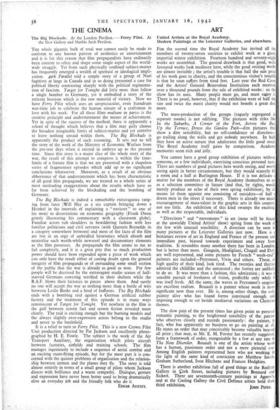THE CINEMA
The Big Blockade. At the London Pavilion.—Ferry Pilot. At the New Gallery and Marble Arch Pavilion.
THE whole gigantic bulk of total war cannot easily be made to conform to any known pattern of aesthetics or entertainment and it is for this reason that film propagandists have ordinarily been content to select and shape some single aspect of the world- wide struggle. Yet from such physically confined subject-matter has frequently emerged a wealth of spiritual or ideological impli- cation. 49th Parallel told a simple story of a group of Nazi fugitives at large in Canada and in so doing presented a case for political liberty contrasting sharply with the political regimenta- tion of fascism. Target for Tonight did little more than follow a single bomber to Germany, yet it embodied a story of the reticent heroism which is the raw material of victory. Now we have Ferry Pilot which uses an unspectacular, even humdrum war-time job to celebrate the human stature of a craftsman in love with his work. For all these films multum in parvo is the creative principle and understatement the means of achievement. Yet in spite of the success of the method, there is apparently a school of thought which believes that a film may gaily choose the broadest imaginable limits of subject-matter and yet contrive to leave nothing unsaid within them. The Big Blockade is apparently the product of such reasoning. It sets out to tell the story of the work of the Ministry of Economic Warfare from the pre-war days when it existed in embryo up to the present time. Since this story is a major slice of the whole story of the war, the result of this attempt to compress it within the time- limits of a feature film is that we are presented with a shapeless series of fragmentary episodes which add up to no significant conclusions whatsoever. Moreover, as a result of an obvious abhorrence of that understatement which has been characteristic of all good film propaganda, we are treated to a whole series of most misleading exaggerations about the results which have so far been achieved by the blockading and the bombing of Germany.
The Big Blockade is indeed a remarkable extravaganza rang- ing from farce (Will Hay as a sea captain bringing down a Heinkel in the intervals of explaining a " navicert " to one of his men) to dissertations on economic geography (Frank Owen grimly illustrating his commentary with a classroom globe). Familiar actors rub shoulders in bewildering fashion with less familiar politicians and civil servants (with Quentin Reynolds in a category somewhere between) and most of the facts of the film are lost in an orgy of unbridled histrionics which absorb and neutralise such worth-while newsreel and documentary elements as the film possesses. As propaganda the film seems to me to fail completely, and it is a great pity that so much production power should have been expended upon a piece of work which can only have the result either of casting doubt upon the general integrity of film propaganda or of persuading some small section of the public that the war is already as good as won. For few people will be deceived by the extravagant studio scenes of half- starved Germans cowering terrified in their shelters while the R.A.F. blows their factories to pieces above them. And surely no one will accept the war as nothing more than a battle of wits between Leslie Banks and a herd of buffoons. The Big Blockade ends with a bombing raid against a German artificial rubber factory and the treatment of this episode is in many ways reminiscent of Target for Tonight. Yet nowhere in the film is the gulf between screen fact and screen fiction revealed more clearly. The raid is exciting enough but the burning models and the always slightly over-expressive actors belong to the studio and never to the battlefield.
It is a relief to turn to Ferry Pilot. This is a new Crown Film Unit production directed by Pat Jackson and excellently photo- graphed by H. E. Fowle. The subject is the work of the Air Transport Auxiliary, the organisation which pilots aircraft between factories, airfields and training schools. The film manages ingeniously to include a sequence of aerial combat and an exciting stunt-flying episode, but for the most part it is con- cerned with the quieter problems of organisation and the relation- ship between airmen and the planes they fly. The story is told almost entirely in terms of a small group of pilots whom Jackson directs with brilliance and a warm sympathy. Dialogue gesture and expression have never been better used to bring dramatically alive an everyday job and the friendly folk who do it.
EDGAR ANSTEY.


























 Previous page
Previous page